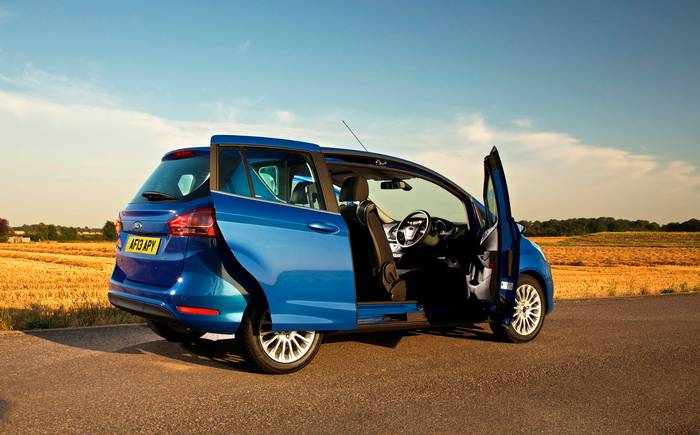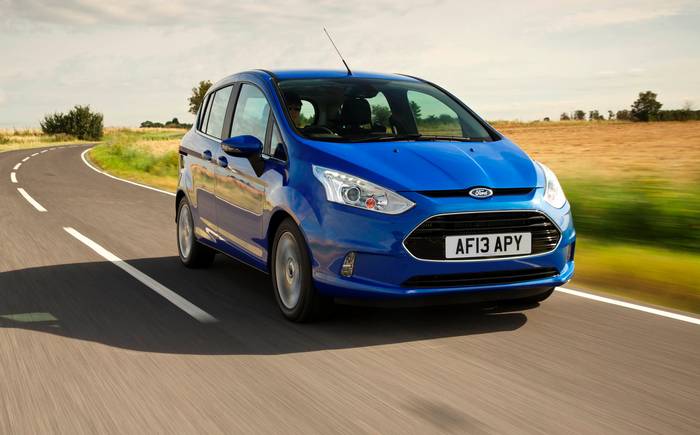Ford B-Max review (2012-on)
The little car with room for the family... and Tom Daley

What is the Ford B-Max?
For the avoidance of doubt, since this car isn’t the only -Max derivative in Ford’s MPV stable (there’s also the C-Max, the Grand C-Max and the S-Max), the B-Max is the small one without a B-pillar – that part of a vehicle’s structure mid-way along its length that connects the roof to the rest of the car and onto which the front doors close and the rears are hinged. It’s also, more interestingly, the car whose launch advertisements, last year, featured a swimmer diving through the resultant, gaping aperture.
It shares its platform with the smaller Ford Fiesta, which means it is smaller than rival MPV the Vauxhall Meriva. However, the Ford’s pillarless doors do at least provide unfettered access to the available space.
Search for and buy a quality used Ford B-Max on driving.co.uk
There are three trims: Studio, Zetec and Titanium. The entry-level Studio is available with only a 90bhp 1.4-litre petrol engine. Zetec is the best-selling trim level and consequently boasts the widest power choice: that 1.4 petrol, a brace of 1.6 diesels (95bhp and 105bhp), a 75bhp1.5 diesel and, most interestingly, a choice of three-cylinder turbocharged petrols (100bhp and 125bhp) promising petrol performance with a hint of diesel parsimony. These last two, plus the 1.6 diesels, also power Titanium-trimmed models.
The drive
Interestingly for a family car, the B-Max has quite a sporty set-up. The steering is precise and direct, the brakes are strong but have plenty of feel, the handling is sharp and involving, and the ride is on the firm side, though still comfortable. However, certain passengers found these driver-centric qualities less welcome. Some complained of feeling nervous in such a lively but short and tall car, as though it might fall over.
And the B-Max has a terrible blind spot created by, ironically, the virtual B-pillar formed from the closed side and front doors. At an angled junction and especially with a front-seat passenger present, it’s very difficult to see what’s coming from the left. It was also an issue for drivers checking over their right shoulder.
At least for the driver, a major part of our test car’s appeal was its keen-as-mustard Ecoboost engine, the 125bhp version that packs a muscly 147 lb ft torque, available from as low as 1,500rpm. It’s a little vocal, though, the engine’s thrummy note betraying its absent fourth cylinder, and it likes to be in the right gear. You need to stir the gearbox to keep it on song.
It’s an economical engine. Over the course of a one-day, 700-mile jaunt, mostly on motorway, our EcoBoost averaged 45mpg. It set us thinking what a diesel-powered B-Max might achieve. Officially, the 95bhp 1.6 TDCi does 70.6mpg on the combined cycle compared with the Ecoboost 125’s 55.4mpg. Based on these figures, the diesel would have been around 20% more economical than the EcoBoost. At £17,495 it is also just 5% more expensive than the EcoBoost 125PS, which costs £16,795. But the diesel is not as quick or entertaining as the EcoBoost and given that the B-Max is likely to spend most of its life doing short journeys, possibly not quite as frugal or clean as the official figures suggest.
The cabin
Few cars try as hard as the B-Max to serve their master, or mistress. The pillarless doors really do make access easier for mums, dads, kids and divers alike. The sliding doors are designed so they open or close with a gentle push. The front seat back folds flat, as do the backs of the rear seats. But the rears don’t slide, so long-legged passengers may feel a bit boxed in and the slightly short boot can’t be extended. This last does at least have a sturdy and removeable floor cover so you can tuck valuable items out of harm’s way, and it’s at the perfect height for a heavy supermarket shop.
Inside the cabin there are plenty of cupholders, while door bins are generously proportioned. The fascia is well organized with controls all logically grouped. It’s smart rather than funky; Ford doing its bit not to alienate older drivers and fleet buyers, perhaps. The absence of conventional B-pillars means that the front seatbelts are anchored within the seats. As a result they have no height adjustment. One particularly tall tester complained of the driver’s belt pulling on his neck.
One neat touch is the all-seeing “eye” located in the headlining above the centre console. Called, in Ford-speak, the “child observation mirror” the highly polished surface gives a wonderful 180-degree view of the kids in the back pulling the wings off flies and generally disturbing the peace. Sticking with bright ideas, there’s also a handy piece of material between the driver’s seat and the centre console, there to catch falling objects, typically, in our experience, the car key which, since the B-Max has a push start, lies unused near the gearstick, ready to slide off at the merest whiff of brake.
The one to buy
Ford B-Max Zetec 1.0 T 125PS EcoBoost
Factfile
- Price:
- £16,795 (correct at time of publishing)
- Engine:
- 999cc, 3 cylinders, turbocharged
- Power:
- 125bhp @ 6000rpm
- Torque:
- 147lb ft @ 1500rpm
- Transmission:
- 5-speed manual
- Acceleration:
- 0-62mph in 11.2sec
- Top speed:
- 117mph
- Fuel:
- 57.7mpg (combined)
- CO2:
- 114g/km
- Road tax band:
- C
- Dimensions:
- L 4077mm, W 1751mm, H 1604mm
Ford B-Max rivals
- Vauxhall Meriva (click to check used car prices on driving.co.uk)
- Seat Altea (click to check used car prices on driving.co.uk)
- Citroën C3 Picasso (click to check used car prices on driving.co.uk)





